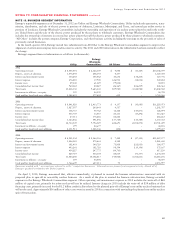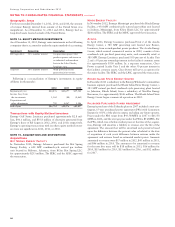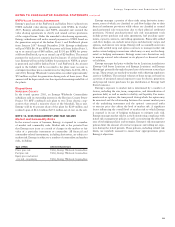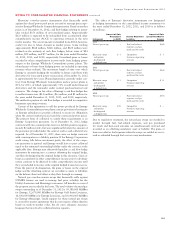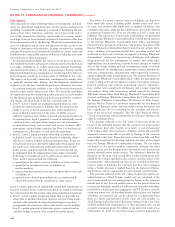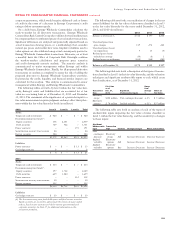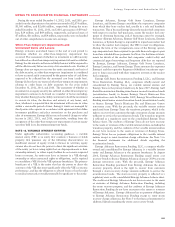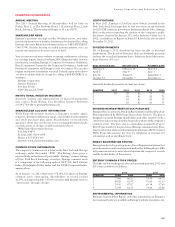Entergy 2012 Annual Report Download - page 107
Download and view the complete annual report
Please find page 107 of the 2012 Entergy annual report below. You can navigate through the pages in the report by either clicking on the pages listed below, or by using the keyword search tool below to find specific information within the annual report.Entergy Corporation and Subsidiaries 2012
NOTES TO CONSOLIDATED FINANCIAL STATEMENTS continued
During the years ended December 31, 2012, 2011, and 2010, pro-
ceeds from the dispositions of securities amounted to $2,074 million,
$1,360 million, and $2,606 million, respectively. During the years
ended December 31, 2012, 2011, and 2010, gross gains of $39 mil-
lion, $29 million, and $69 million, respectively, and gross losses of
$7 million, $11 million, and $9 million, respectively, were reclassified
out of other comprehensive income into earnings.
Other-Than-Temporary Impairments and
Unrealized Gains and Losses
Entergy evaluates unrealized losses at the end of each period to
determine whether an other-than-temporary impairment has
occurred. The assessment of whether an investment in a debt security
has suffered an other-than-temporary impairment is based on whether
Entergy has the intent to sell or more likely than not will be required to
sell the debt security before recovery of its amortized costs. Further, if
Entergy does not expect to recover the entire amortized cost basis of
the debt security, an other-than-temporary impairment is considered
to have occurred and it is measured by the present value of cash flows
expected to be collected less the amortized cost basis (credit loss).
Entergy did not have any material other-than-temporary impairments
relating to credit losses on debt securities for the years ended
December 31, 2012, 2011, and 2010. The assessment of whether an
investment in an equity security has suffered an other-than-temporary
impairment continues to be based on a number of factors including,
first, whether Entergy has the ability and intent to hold the investment
to recover its value, the duration and severity of any losses, and,
then, whether it is expected that the investment will recover its value
within a reasonable period of time. Entergy’s trusts are managed by
third parties who operate in accordance with agreements that define
investment guidelines and place restrictions on the purchases and
sales of investments. Entergy did not record material charges to other
income in 2012, 2011, and 2010, respectively, resulting from the
recognition of the other-than-temporary impairment of certain equity
securities held in its decommissioning trust funds.
NOTE 18. VARIABLE INTEREST ENTITIES
Under applicable authoritative accounting guidance, a variable
interest entity (VIE) is an entity that conducts a business or holds
property that possesses any of the following characteristics: an
insufficient amount of equity at risk to finance its activities, equity
owners who do not have the power to direct the significant activities
of the entity (or have voting rights that are disproportionate to their
ownership interest), or where equity holders do not receive expected
losses or returns. An entity may have an interest in a VIE through
ownership or other contractual rights or obligations, and is required
to consolidate a VIE if it is the VIE’s primary beneficiary. The primary
beneficiary of a VIE is the entity that has the power to direct the
activities of the VIE that most significantly affect the VIE’s economic
performance, and has the obligation to absorb losses or has the right
to residual returns that would potentially be significant to the entity.
Entergy Arkansas, Entergy Gulf States Louisiana, Entergy
Louisiana, and System Energy consolidate the respective companies
from which they lease nuclear fuel, usually in a sale and leaseback
transaction. This is because Entergy directs the nuclear fuel companies
with respect to nuclear fuel purchases, assists the nuclear fuel com-
panies in obtaining financing, and, if financing cannot be arranged,
the lessee (Entergy Arkansas, Entergy Gulf States Louisiana, Entergy
Louisiana, or System Energy) is responsible to repurchase nuclear fuel
to allow the nuclear fuel company (the VIE) to meet its obligations.
During the term of the arrangements, none of the Entergy operat-
ing companies have been required to provide financial support apart
from their scheduled lease payments. See Note 4 to the financial state-
ments for details of the nuclear fuel companies’ credit facility and
commercial paper borrowings and long-term debt that are reported
by Entergy, Entergy Arkansas, Entergy Gulf States Louisiana,
Entergy Louisiana, and System Energy. These amounts also represent
Entergy’s and the respective Registrant Subsidiary’s maximum expo-
sure to losses associated with their respective interests in the nuclear
fuel companies.
Entergy Gulf States Reconstruction Funding I, LLC, and Entergy
Texas Restoration Funding, LLC, companies wholly-owned and
consolidated by Entergy Texas, are variable interest entities and
Entergy Texas is the primary beneficiary. In June 2007, Entergy Gulf
States Reconstruction Funding issued senior secured transition bonds
(securitization bonds) to finance Entergy Texas’s Hurricane Rita
reconstruction costs. In November 2009, Entergy Texas Restoration
Funding issued senior secured transition bonds (securitization bonds)
to finance Entergy Texas’s Hurricane Ike and Hurricane Gustav
restoration costs. With the proceeds, the variable interest entities
purchased from Entergy Texas the transition property, which is the
right to recover from customers through a transition charge amounts
sufficient to service the securitization bonds. The transition property
is reflected as a regulatory asset on the consolidated Entergy Texas
balance sheet. The creditors of Entergy Texas do not have recourse
to the assets or revenues of the variable interest entities, including the
transition property, and the creditors of the variable interest entities
do not have recourse to the assets or revenues of Entergy Texas.
Entergy Texas has no payment obligations to the variable interest
entities except to remit transition charge collections. See Note 5 to
the financial statements for additional details regarding the
securitization bonds.
Entergy Arkansas Restoration Funding, LLC, a company wholly-
owned and consolidated by Entergy Arkansas, is a variable interest
entity and Entergy Arkansas is the primary beneficiary. In August
2010, Entergy Arkansas Restoration Funding issued storm cost
recovery bonds to finance Entergy Arkansas’s January 2009 ice storm
damage restoration costs. With the proceeds, Entergy Arkansas
Restoration Funding purchased from Entergy Arkansas the storm
recovery property, which is the right to recover from customers
through a storm recovery charge amounts sufficient to service the
securitization bonds. The storm recovery property is reflected as a
regulatory asset on the consolidated Entergy Arkansas balance sheet.
The creditors of Entergy Arkansas do not have recourse to the assets
or revenues of Entergy Arkansas Restoration Funding, including
the storm recovery property, and the creditors of Entergy Arkansas
Restoration Funding do not have recourse to the assets or revenues
of Entergy Arkansas. Entergy Arkansas has no payment obligations
to Entergy Arkansas Restoration Funding except to remit storm
recovery charge collections. See Note 5 to the financial statements for
additional details regarding the storm cost recovery bonds.
105




